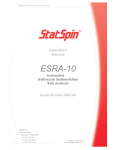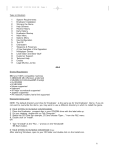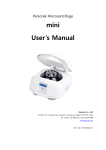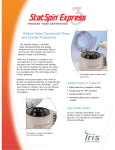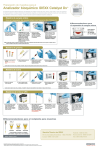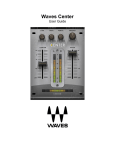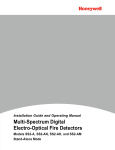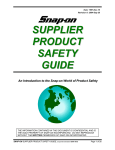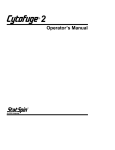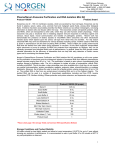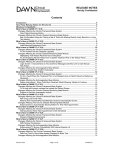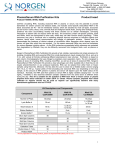Download User`s Manual - Web Hosting in Massachusetts MA and New
Transcript
INSTRUCTIONS FOR USE MICRO BLOOD COLLECTORS, Product Numbers SS2H, SS2U & SS2X INTENDED USE For collection and processing of capillary blood to prepare plasma/serum. SUMMARY The StatSampler requires assembly before use by inserting the Capillary tube, the end with the colored band first, through the split stopper (See figure 1). Finger-stick blood is collected into a Capillary tube and then turned to the vertical position allowing the blood to drain into the MicroTube from which it can be rapidly separated for the preparation of plasma/serum. StatSampler blood collectors combine the advantages of: 1.) Immediate anticoagulation in the Capillary tube 2.) Ease of collection in a Capillary tube 3.) Reduction in technique dependency in collecting capillary blood 4.) Isolation of cells by a barrier gel. CONTENTS 1. 50 Capillary tubes 2. 50 MicroTubes 3. 4. 3 Pipette bulbs 10 non-split stoppers ANTICOAGULANT (not included in serum preparation kit) Each Capillary tube contains enough lithium heparin (or EDTA) to anticoagulate 200µl of blood. There is no anticoagulant contained in the MicroTube portion of the StatSampler. If a volume of blood greater than 200µl is required, then a second Capillary tube must be used to ensure the proper anticoagulant/ blood ratio. STORAGE Store kit in a cool dry place. "USE BEFORE" DATE StatSampler capillary tubes containing anticoagulant should not be used beyond the date stated on the vial label. For in vitro diagnostic use. PRODUCT DIFFERENCES SS2H Lithium heparin treated SS2U Untreated SS2X EDTA treated PROCEDURE 1. Label the StatSampler MicroTube with a marking pen, if desired, with patient i.d., date, time. 2. Assemble the StatSampler by carefully inserting a Capillary tube, (the end with the colored band first) into the Micro Tube through the split stopper. Hold the Capillary tube near the end being inserted and carefully push it in until the colored band is even with the top of the stopper (See Figure 1). CAUTION - ALWAYS ASSEMBLE THE STATSAMPLER BEFORE BLOOD COLLECTION TO PREVENT UNNECESSARY EXPOSURE TO BLOODBORNE PATHOGENS AND TO MINIMIZE BLOOD SPILLAGE AND POSSIBLE TUBE BREAKAGE. PROCEDURE (cont.) 3. Perform a “finger-stick” using good laboratory practice. HELPFUL HINTS FOR COLLECTION OF CAPILLARY BLOOD SPECIMENS* *as outlined in the NCCLS publication; Procedures for the Collection of Diagnostic Blood Specimens by Skin Puncture Second Edition; Approved Standard. NCCLS publication H4-A2. Villanova, PA: July 1986. CHOOSING A SITE 3a. The site of choice, in adults and older children, would be the palmar (finger print) surface of the finger. Do not use the side or tip of the finger. Tissue thickness found in these locations is about half that found in the center of the finger. 3b. Infants under the age of one year should have skin puncture procedures performed on either the lateral or medial plantar surface of the heel or the plantar surface of a big toe. This is to avoid injury to the infant from skin puncture of an insufficient tissue depth area. It is imperative that the depth of puncture in the infant not exceed 2.4 mm to avoid penetrating bone and the risk of osteomyelitis.(3) The optimum puncture depth of the heel in the newborn is between 0.35 and 1.6 mm beneath the skin surface as this is where the major blood vessels are located.(3) SITE PREPARATION 3c. Warm the site. Warming of the site drastically increases blood flow to the area, resulting in a larger quantity of blood collected. When following proper collection procedures, up to 0.5 ml of blood can be obtained from a single puncture site. Warming is achieved by either applying a warm compress to the site or placing the site under warm running water. The site should be warmed at a temperature not to exceed 42oC for a minimum of three minutes. 3d. Clean the puncture site. Use a commercially prepared alcohol pad or a 75% aqueous solution of isopropanol. After cleaning, thoroughly dry the site with a sterile gauze pad. Residual alcohol can cause hemolysis. Do not cleanse area with betadine as it may cause an elevation of potassium, phosphorus, and uric acid. 8. Following collection, StatSampler MicroTubes for serum preparation should be allowed to clot for at least 30 minutes before centrifugation. Treated samples can be spun immediately to yield plasma. Centrifugation: ● StatSpin centrifuges. With StatSpin models RP or MP (earlier models 1 & 3) centrifuge with the RT12 rotor (or equivalent) using the “Tube Rotor /30 seconds” cycle to prepare plasma or serum. ● Low-speed clinical centrifuges. Centrifuge at 1500 rcf for 20 minutes. The StatSampler MicroTube may be placed in a larger plastic centrifuge tube for easier access. ● High-speed microcentrifuges. Centrifuge for 2 minutes. BARRIER GEL MicroTubes for plasma/serum separation contain an inert barrier material which has a density between that of cells and plasma. During centrifugation the inert barrier gel rises to the plasma/cell interface where it lodges and forms a physical barrier between the liquid portion and cells. This inhibits re-mixing of the red cells with the plasma. (See figure 3) LIMITATIONS StatSampler has been designed for capillary blood collection. Chemistry values obtained from skin puncture specimens may differ from those obtained by venipuncture.(1,2) Milking the skin may cause hemolysis and thus affect the accuracy of some determinations. Capillary tubes treated with lithium heparin or EDTA have been wide-ly used in the collection of blood and the subsequent preparation of plasma. This product should perform in a similar manner. However, the user should determine that plasma of adequate quality for their testing purposes is produced by StatSampler Micro Blood Collectors. 3e. Puncture the site. A commercial lancet device, either automated (spring loaded) or manual, is available in a wide variety of styles for uniform depth punctures. The Tenderfoot by I.T.C. should be used if the specimen is obtained from an infant.(4) This specially designed device delivers a cut that is only 1mm in depth, preventing injury to the infant’s heel bone and surrounding tissue. Incisions between 0.35 and 1.6 mm in depth leave virtually no hematoma and allow for subsequent sampling from the same region.(4) Figure 1 SPECIMEN COLLECTION 3f. After blood flow has begun, wipe off the first drop. Angle the puncture site downward so as to facilitate blood flow. Be certain not to “milk” the appendage; a steady firm pressure is preferable if required. 4. Hold the StatSampler assembly by the Capillary tube. Collect the sample in the StatSampler, taking care not to press the opening of the Capillary tube to the skin. After wiping off the first drop of blood, aspirate blood into the Capillary tube as it appears at the wound. Tilt the tube horizontally or slightly upward. Avoid introducing any air bubbles into the Capillary tube. 5. Fill the Capillary tube to the end; fill volume is approximately 200 µL. 6. Turn the assembly to the vertical position; the blood will drain into the MicroTube (See Figure 2). To discharge the last drop of blood into the MicroTube, wipe the Capillary end with a lab tissue, then place a pipette bulb (included in your kit) over the top of the Capillary tube. Squeeze a puff of air into the Capillary tube to expel the last drop. Save the pipette bulb. 7. Remove and discard the Capillary tube. Gently shake the MicroTube to ensure mixing of the anticoagulant. Plasma Gel Cells Figure 2 Figure 3 REFERENCES: 1. Procedures for the Collections of Diagnostic Blood Specimens by Skin Puncture - Second Edition; Approved Standard. NCCLS publication H4-A3. Villanova, PA: July 1986. 2. Blumenfeld, T. A., Hertelendy, W. G., and Ford, S.H. Simultaneously obtained skin puncture serum, skin puncture plasma and venous serum compared and effects of warming the skin before puncture. Clin. Chem. 23:1705, 1977 3. Meites, Samuel. Skin-Puncture and Blood-Collecting Technique for Infants; Update and Problems. Clin. Chem. 34:1890-1894, 1988. 4. Burns, Edward R.. Development and Evaluation of a New Instrument for Safe Heel-stick Sampling of Neonates; Lab. Med. 20: 481-483, July 1989. Telephone 781-551-0100 Toll free 800-782-8774 Telefax 781-551-0036 StatSampler Patent Number 5,257,984. 85 Morse Street Norwood, Massachusetts 02062 USA StatSpin and StatSampler are registered trademarks of StatSpin , Inc. ssxuh-M.p65 7/20/98 54-001696-001 REV. M INSTRUCTIONS FOR USE EDTA TREATED MICRO BLOOD COLLECTORS, Product Numbers SS1E & SS2E INTENDED USE For capillary collection of whole blood. SUMMARY The StatSampler requires assembly before use by inserting the Capillary tube, the end with the colored band first, through the split stopper (See figure 1). Finger-stick blood is collected into a Capillary tube and then turned to the vertical position allowing the blood to drain into the MicroTube from which it can be used as a whole blood sample. StatSampler blood collectors combine the advantages of: 1.) Immediate anticoagulation in the Capillary tube 2.) Ease of collection in a Capillary tube 3.) Reduction in technique dependency in collecting capillary blood CONTENTS 1. 50 EDTA treated Capillary tubes 2. 50 MicroTubes with attached stoppers 3. 3 Pipette bulbs ANTICOAGULANT Each Capillary tube contains enough EDTA to anticoagulate the designated fill volume of blood. There is no anticoagulant contained in the MicroTube portion of the StatSampler. If a volume of blood greater than the designated fill volume is required, then a second Capillary tube must be used to ensure the proper anticoagulant / blood ratio. STORAGE Keep vial of capillary tubes closed while not in use. Store kit in a cool dry place. "USE BEFORE" DATE StatSampler capillary tubes containing anticoagulant should not be used beyond the date stated on the vial label. For in vitro diagnostic use. PRODUCT DIFFERENCES SS1E Designated Fill Volume = SS2E Designated Fill Volume = 100 µL 200 µL PROCEDURE 1. Label the StatSampler MicroTube with a marking pen, if desired, with patient i.d., date, time. 2. Assemble the StatSampler by carefully inserting a Capillary tube, (the end with the colored band first) into the MicroTube through the split stopper. Hold the Capillary tube near the end being inserted and carefully push it in until the colored band is even with the top of the stopper (See Figure 1). CAUTION - ALWAYS ASSEMBLE THE STATSAMPLER BEFORE BLOOD COLLECTION TO PREVENT UNNECESSARY EXPOSURE TO BLOODBORNE PATHOGENS AND TO MINIMIZE BLOOD SPILLAGE AND POSSIBLE TUBE BREAKAGE. PROCEDURE (cont.) 6. Turn the assembly to the vertical position; the blood will drain into the MicroTube (See Figure 2). To discharge the last drop of blood into the MicroTube, wipe the Capillary end with a lab tissue, then place a pipette bulb (included in your kit) over the top of the Capillary tube. Squeeze a puff of air into the Capillary tube to expel the last drop. Save the pipette bulb. 7. Remove and discard the Capillary tube and split stopper. Secure purple cap to close MicroTube. Gently shake the MicroTube to ensure mixing of the anticoagulant. 3. Perform a “finger-stick” using good laboratory practice. HELPFUL HINTS FOR COLLECTION OF CAPILLARY BLOOD SPECIMENS* *as outlined in the NCCLS publication; Procedures for the Collection of Diagnostic Blood Specimens by Skin Puncture Second Edition; Approved Standard. NCCLS publication H4-A2. Villanova, PA: July 1986. CHOOSING A SITE 3a. The site of choice, in adults and older children, would be the palmar (finger print) surface of the finger. Do not use the side or tip of the finger. Tissue thickness found in these locations is about half that found in the center of the finger. 3b. Infants under the age of one year should have skin puncture procedures performed on either the lateral or medial plantar surface of the heel or the plantar surface of a big toe. This is to avoid injury to the infant from skin puncture of an insufficient tissue depth area. It is imperative that the depth of puncture in the infant not exceed 2.4 mm to avoid penetrating bone and the risk of osteomyelitis.(3) The optimum puncture depth of the heel in the newborn is between 0.35 and 1.6 mm beneath the skin surface as this is where the major blood vessels are located.(3) Note: 8. Transfer the blood in the Capillary tube into the microtube as soon as possible and mix thoroughly. After mixing, the sample is stable for 2-4 hours. (1) Following collection, EDTA treated blood should be thoroughly remixed just before use. SITE PREPARATION Figure 1 3c. Warm the site. Warming of the site drastically increases blood flow to the area, resulting in a larger quantity of blood collected. When following proper collection procedures, up to 0.5 ml of blood can be obtained from a single puncture site. Warming is achieved by either applying a warm compress to the site or placing the site under warm running water. The site should be warmed at a temperature not to exceed 42oC for a minimum of three minutes. 3d. Clean the puncture site. Use a commercially prepared alcohol pad or a 75% aqueous solution of isopropanol. After cleaning, thoroughly dry the site with a sterile gauze pad. Residual alcohol can cause hemolysis. Do not cleanse area with betadine as it may cause an elevation of potassium, phosphorus, and uric acid. 3e. Puncture the site. A commercial lancet device, either automated (spring loaded) or manual, is available in a wide variety of styles for uniform depth punctures. The Tenderfoot by I.T.C. should be used if the specimen is obtained from an infant.(4) This specially designed device delivers a cut that is only 1mm in depth, preventing injury to the infant’s heel bone and surrounding tissue. Incisions between 0.35 and 1.6 mm in depth leave virtually no hematoma and allow for subsequent sampling from the same region.(4) SPECIMEN COLLECTION 3f. 4. 5. After blood flow has begun, wipe off the first drop. Angle the puncture site downward so as to facilitate blood flow. Be certain not to “milk” the appendage; a steady firm pressure is preferable, if required. Hold the StatSampler assembly by the Capillary tube. Collect the sample in the StatSampler, taking care not to press the opening of the Capillary tube to the skin. After wiping off the first drop of blood, aspirate blood into the Capillary tube as it appears at the wound. The blood must be free flowing and not intermittent (starting and stopping), otherwise clots may form. Tilt the tube horizontally or slightly upward. Avoid introducing any air bubbles into the Capillary tube. Fill the Capillary tube to the end; if larger volume is desired, use a fresh Capillary tube to maintain proper blood / anticoagulant ratio. Remove and discard capillary tube and split cap. Figure 2 Figure 3 LIMITATIONS StatSampler has been designed for capillary blood collection. Values obtained from skin puncture specimens may differ from those obtained by venipuncture.(1,2) Milking the skin may cause hemolysis and thus affect the accuracy of some determinations. Some clotting may occur with non-free flowing blood. REFERENCES: 1. Procedures for the Collections of Diagnostic Blood Specimens by Skin Puncture - Second Edition; Approved Standard. NCCLS publication H4-A3. Villanova, PA: July 1986. 2. Blumenfeld, T. A., Hertelendy, W. G., and Ford, S.H. Simultaneously obtained skin puncture serum, skin puncture plasma and venous serum compared and effects of warming the skin before puncture. Clin. Chem. 23:1705, 1977 3. Meites, Samuel. Skin-Puncture and Blood-Collecting Technique for Infants; Update and Problems. Clin. Chem. 34:1890-1894, 1988. 4. Burns, Edward R.. Development and Evaluation of a New Instrument for Safe Heel-stick Sampling of Neonates; Lab. Med. 20: 481-483, July 1989. StatSpin, Inc. 85 Morse Street Norwood, MA 02062 Tel: Fax: 800-782-8774 781-551-0100 781-551-0036 StatSampler Patent Number 5,257,984. StatSampler and StatSpin are registered trademarks of StatSpin, Inc., an IRIS Company. SS2E-1EF.p65 9/08/00 54-002861-001 REV. F




